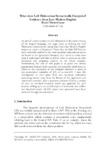Mostrar o rexistro simple do ítem
What does Left Dislocation Syntactically Comprise? Evidence from Late Modern English
| dc.contributor.author | Tizón-Couto, David | |
| dc.date.accessioned | 2016-07-15T08:35:35Z | |
| dc.date.available | 2016-07-15T08:35:35Z | |
| dc.date.issued | 2008 | |
| dc.identifier.citation | AEDEAN 2008, 31: 815-825 ISBN-978-84-9749-278-2 | |
| dc.identifier.isbn | 978-84-9749-278-2 | |
| dc.identifier.uri | http://hdl.handle.net/2183/17095 | |
| dc.description.abstract | [Abstract] As part of a major project on left dislocation in the recent history of the English language, this paper aims at defining the Left Dislocation phenomenon taking data from a late Modern English corpus as a point of departure. Given that the label LD has not been uniformly applied to the same periphery phenomena across the board in the specialized literature, it is crucial to make clear what I understand and label as LD in order to continue on with functional and pragmatic analyses in my future research. Furthermore, the aim of this paper is to point out several grammatical features (both syntactic and semantic) which have an effect on the conception of the examples retrieved as more or less prototypical examples of LD, or as non-LD. I base this investigation on data taken from two electronic collections containing literary texts from the Britain of the eighteenth and nineteenth centuries. After a previous selection of texts, a corpus of over six hundred thousand words was gathered for each century, adding up to an overall corpus of more than one million two hundred words. All LD tokens here presented have been retrieved through manual search. | |
| dc.language.iso | eng | |
| dc.publisher | Universidade da Coruña | |
| dc.title | What does Left Dislocation Syntactically Comprise? Evidence from Late Modern English | |
| dc.type | info:eu-repo/semantics/conferenceObject | |
| dc.rights.access | info:eu-repo/semantics/openAccess |






